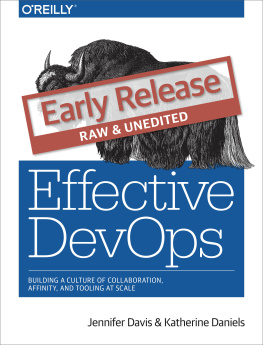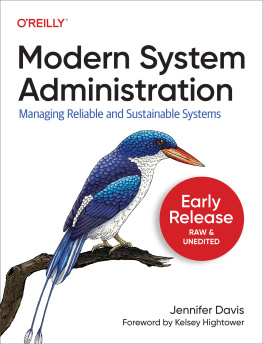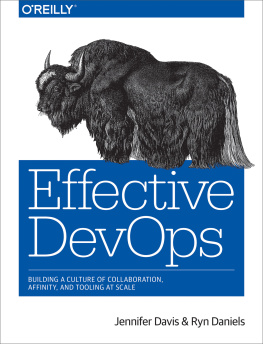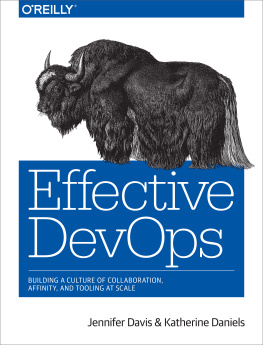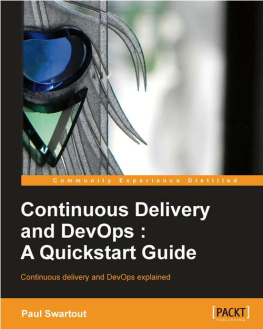Effective DevOps
by Jennifer Davis and Katherine Daniels
Copyright 2015 Jennifer Davis and Katherine Daniels. All rights reserved.
Printed in the United States of America.
Published by OReilly Media, Inc. , 1005 Gravenstein Highway North, Sebastopol, CA 95472.
OReilly books may be purchased for educational, business, or sales promotional use. Online editions are also available for most titles ( http://safaribooksonline.com ). For more information, contact our corporate/institutional sales department: 800-998-9938 or corporate@oreilly.com .
- Editor: Brian Anderson
- Production Editor: FILL IN PRODUCTION EDITOR
- Copyeditor: FILL IN COPYEDITOR
- Proofreader: FILL IN PROOFREADER
- Indexer: FILL IN INDEXER
- Interior Designer: David Futato
- Cover Designer: Karen Montgomery
- Illustrator: Rebecca Demarest
- February 2016: First Edition
Revision History for the First Early Release Edition
- 2015-05-05: First Release
- 2015-07-22: Second Release
See http://oreilly.com/catalog/errata.csp?isbn=9781491926307 for release details.
The OReilly logo is a registered trademark of OReilly Media, Inc. Effective DevOps, the cover image, and related trade dress are trademarks of OReilly Media, Inc.
While the publisher and the author(s) have used good faith efforts to ensure that the information and instructions contained in this work are accurate, the publisher and the author(s) disclaim all responsibility for errors or omissions, including without limitation responsibility for damages resulting from the use of or reliance on this work. Use of the information and instructions contained in this work is at your own risk. If any code samples or other technology this work contains or describes is subject to open source licenses or the intellectual property rights of others, it is your responsibility to ensure that your use thereof complies with such licenses and/or rights.
978-1-491-92630-7
[FILL IN]
Chapter 1. Introduction
Early Release Edition
This book is a work in progress new chapters will be added as they are written. We welcome feedback if you spot any errors or would like to suggest improvements, please let us know.
Who This Book Is For
This book is aimed primarily at managers and individual contributors in leadership roles who see friction within their organizations and are looking for concrete, actionable steps they can take towards implementing or improving a devops culture in their work environment. However, individual contributors of all levels who want practical suggestions for easing some of the pain points they face will find actionable takeaways.
The audience is made up of a mix of professional roles, as devops is a professional and cultural movement that stresses the iterative efforts to break down information silos, monitor relationships and repair when misunderstandings arise between teams in an organization. Many may be leaders within their organizations who have worked closely with developers or operations engineers.
The book covers a wide range of devops skills and theory, including an introduction to the basic ideas and concepts. It is assumed that you will have heard of the term devops and perhaps have a rudimentary understanding of devops, tools and processes used in the field.
By the end of Effective Devops, our hope is that you will have a solid understanding of what having a devops culture means practically for your organization, how to encourage effective collaboration to help indivdiual contributors from different backgrounds and teams deal with different goals and working styles to work together productively, how to help teams collaborate to maximize value between them while increasing employee satisfaction and balancing conflicting organizational goals, and how to choose tools and workflows for your organization that complement your organization.
How this Book Is Organized
This book is broken down into several parts, starting with an introductory chapter and then covering each of the pillars of devops.
- Chapter I, What is Devops
- Chapter II, Collaboration: Individuals Working Together
- Chapter III, Hiring: Choosing Individuals
- Chapter IV, Affinity: From Individuals to Teams
- Chapter V, Tools: Choosing and Using Them
- Chapter VI, Scale: Scaling Everything UP
Conventions Used in This Book
Using Code Examples
How to Contact Us
We have a web page for this book, where we list errata, examples, and any additional information. You can access this page at http://effectivedevops.net.
To comment or ask technical questions about this book, send email to .
Acknowledgements
Effective Devops would not have been possible without the help and guidance of many friends, colleagues, and family members.
Chapter 2. What is Devops?
What is devops? Some might define it as a software development method, while others might think that it is a set of tools and technologies such as configuration management and continuous delivery. We would argue instead that devops is a cultural movement that seeks to improve both software development and the professional lives of the people involved in the field. In order to fully understand what we mean when were talking about devops, it is necessary to understand not only what the concept means and how it is used today, but also the history of how it came to be.
No cultural movement exists in a vacuum. Technology is part of culture. We are born, accept what is and introduce new cultural aspects as we live. The way that our overall culture influences technology, and technology influences culture shapes the fabric of how we live our lives.
Pre-1880, walking was the primary mode of transportation. Cities were compact with residences and workplaces intermingled. Streets were narrow and inconsistently paved. As automobiles were introduced, cities made decisions about the organization and infrastructure either in favor of automobiles or existing pedestrians. These days, some cities forgo infrastructure planning that factors in pedestrians at all creating busy roadways with no safe way to travel by foot. Walking shaped the city and how we worked, and the arrival of new technology changed the landscape accordingly.
Devops is part of the cultural weave that shapes how we work and why. While devops does involve certain tools and technologies, an equally important part of our culture is our values, norms, and knowledge. Examining how people work, the technologies that we use, how technology influeces how we work, and how people influence technology can help us make intentional decisions about the landscape of our industry.
This chapter will delve into the evolution of software engineering as it pertains to the history of devops, define the terms and ideas closest to the movement, and address some common misconceptions that people often have about the subject. Unlike most histories on the topic, which often start slightly before the first DevOpsDays conference in 2009, we will go back further so the reader can gain a richer understanding of the ideas and principles that have shaped our industry over time, and how that continued evolution has changed and grown, making devops not only necessary but inevitable.
The History of Devops
In this section we will examine the history of the industry and how the recurring patterns and ideas have shaped the devops movement.
Developer as Operator
In the beginning, the developer was the operator. Early programmers were actually known as human computers. Jean Bartik, one of the original programmers of the Electronic Numeric Integrator and Computer (ENIAC) learned how to program the machine by reviewing hardware and logic diagrams of the device. Programming the machine and its 18,000 vacuum tubes meant setting dials and changing out cable connections across 40 control panels. At the time, the focus was on the hardware engineering and not on the software that Bartik, Kathleen Antonelli, Frances Holberton, Marlyn Meltzer, Frances Spence, and Ruth Teitelbaum built on the ENIAC. These women felt the pain to manage the systems as they had to replace fuses and cables. There were literal bugs in the system.

